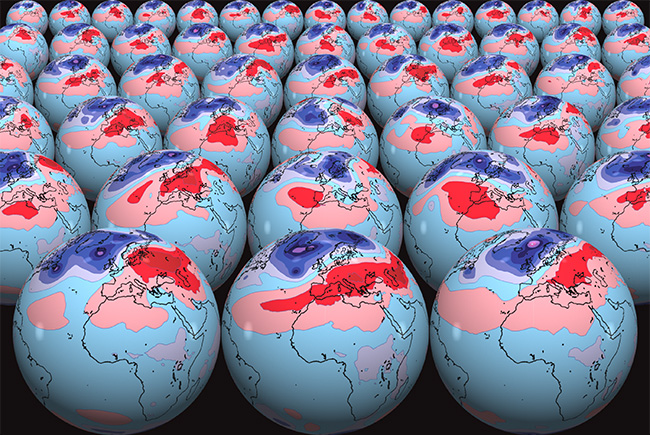

What is ensemble weather forecasting?
An ensemble weather forecast is a set of forecasts that present the range of future weather possibilities. Multiple simulations are run, each with a slight variation of its initial conditions and with slightly perturbed weather models. These variations represent the inevitable uncertainty in the initial conditions and approximations in the models. They produce a range of possible weather conditions.
Why is it important to measure the level of uncertainty in a forecast?
The uncertainty associated with every forecast means that different scenarios are possible, and the forecast should reflect that. Single ‘deterministic’ forecasts can be misleading as they fail to provide this information. Take agriculture as an example: a farmer needs to know the range of possible conditions the crops may experience so that they can be protected. Ensemble forecasts show how big that range is at different forecast times.
What are the advantages of ensemble prediction?
By generating a range of possible outcomes, the method can show how likely different scenarios are in the days ahead, and how long into the future the forecasts are useful. The smaller the range of predicted outcomes, the ‘sharper’ the forecast is said to be. Good ensemble forecasts are not just as sharp as possible but also reliable. If a reliable forecast says that there is a 70% chance of top temperatures rising above a certain threshold, then in 70% of cases when such a forecast is made temperatures will indeed rise above that threshold.
Is uncertainty in a forecast due to a lack of knowledge?
Yes, to some extent our lack of knowledge does significantly increase uncertainty in the forecast. This is why there is much work going into improving our knowledge of initial conditions and of atmospheric processes that computer models need to mirror. In addition, the atmosphere is a chaotic system. This means that it is sensitively dependent on initial conditions. In a chaotic system, a slight change in the input conditions can lead to a significant change in the output forecast. In a non-chaotic system, small differences in initial conditions only give small differences in output. Hence, it is important in weather forecasting to investigate how sensitive the atmosphere is at any stage to initial conditions. Ensemble forecasting does this by looking at a spread of possible outcomes.
When did ECMWF introduce ensemble forecasting?
ECMWF started to provide operational weather predictions in 1979. These first forecasts were offered without an uncertainty estimate, and so a research effort to investigate such an approach was initiated in the 1980s. It took more than a decade to develop a workable ensemble prediction technique, and ECMWF produced the first ensemble forecasts in 1992.
How does ECMWF produce an ensemble forecast?
It produces 51 forecasts. One of these is known as the control forecast and is produced with the best available data and unperturbed models. The other 50 are each produced with slight perturbations of initial conditions and of the models. Taken together the forecasts become the ensemble, which shows the range of possible outcomes and the likelihood of their occurrence.
What is the future of ensemble forecasting?
ECMWF published its ten-year Strategy in 2016. Titled The Strength of a Common Goal, it stressed the primary position of ensemble forecasting within the organisation.
Download as PDF
![]() Fact sheet: Ensemble weather forecasting
Fact sheet: Ensemble weather forecasting
This video marks 25 years of ensemble forecasting at ECMWF. Lead Scientist Roberto Buizza, Director-General Florence Rabier and NOAA meteorologist Tom Hamill explain the rationale behind ensemble forecasting and set out what the future holds.
